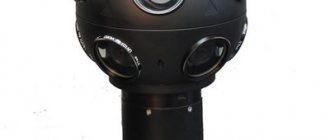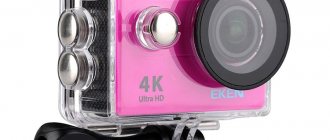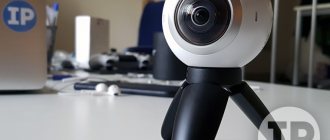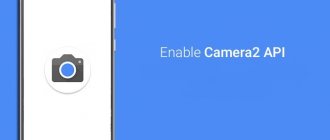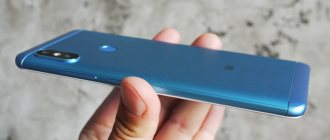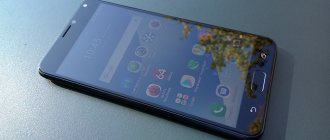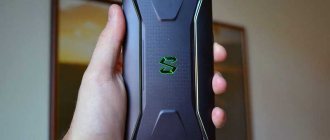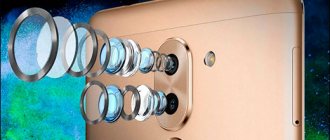Andrey loves sports and travel. And YouTube loves Andrey and constantly offers videos of travel bloggers with clips of their trips and extreme travels. The fisheye, dynamics and energetic music from the video were so popular that Andrey was already planning to buy his own action camera.
The top budget cameras open before the hero: hardworking Chinese, Canadians and Japanese are fighting for his attention. Today we will take 6 cameras from the same price category, and go over the characteristics, pros and cons. Andrei philosophically remarked to himself that everything is learned by comparison.
SJCAM SJ5000 WIFI
average price – 93$.
Device
Action camera from China with a 1.5-inch display.
Filming
A camera with a 14-megapixel matrix at its limit produces a resolution of 1920x1080 for video at 30 fps.
For a blog on Andrey’s knee, FullHD video is already enough, but SJCAM can also take photos in 4K. It has an aperture of 2.8 - this is not up to the level of a portrait lens in a DSLR, but a decent value for a camera.
In the box
The manufacturers included everything they could in the kit. Just look at this list:
- Waterproof case
- Belt clip
- Velcro fastenings
- Quick release fasteners – vertical and horizontal
- Mount for flat surfaces
- Helmet mount
- USB cable
- Glass cloth
Other characteristics
6x zoom
underwater photography at a depth of up to 30m
74 grams weight
supports Wi-Fi (via the application you can duplicate the image from the display to your phone or tablet)
HDMI output
Functions
SlowMotion
Time Lapse
When the device is connected to a computer, it can work in webcam mode
If necessary, replace the DVR - there is a motion sensor for this
Liked:
Lots of accessories included, all compatible with GoPro
There are photos in 4K
Turns USB into a cool webcam
Motion sensor and the ability to replace the recorder
Controlling the camera via the app: I installed the camera in the nursery and got a video nanny
Did not like:
Memory cards up to 32GB
Shooting speed only 30 fps
The battery lasts for 1.5 hours, you need to buy a spare one
Our hero shrugs his shoulders. Let's look again.
Macro photography
As it turned out, the most difficult stage for our competitors. I didn't expect so many different options. Almost every smartphone has defined the color red in a very unique way. Many found it difficult to tell the difference between red and orange, causing the leaves to simply turn into a red mush. But now you will see everything for yourself.
Google Pixel 2
“Pixel” has the most true color rendition. The colors are not bright like in photos taken with iPhones, and not as faded as in Samsung and Xiaomi. This photograph is distinguished by its volume - the wall is the correct brown color and without lighting defects.
According to the standard, everything is fine and with detail on the crop: you can easily see the pores of the leaf, there are no artifacts on its border - the matrix worked perfectly.
iPhone 7 Plus
Here come the eye-rolling options. The orange stripes on the sheet are not visible at all - they have merged into an incomprehensible color mess, and the photo itself looks oversaturated. Very bad.
The crop shows artifacts at the border of the sprout and the leaf - the photo appears to be blurred, but this is not the case, since pimples on the leaf are visible.
iPhone X
This picture already looks nicer: the orange color is not so “eaten up” by the matrix, which does not understand what is happening at all.
The detailing on the crop is also better than on the “seven”, but the colors are generally scary.
iPhone XS
What happened here is unclear. The leaf I spray is red, not orange. Immediately the image processing coprocessor simply went crazy and colored the picture in a very unique way. From the point of view of impartiality of information transfer, the two new iPhones did the worst job.
But in terms of detail, it’s a little better than the “ten”. But that doesn't make the photo good. Apple, don't do this.
iPhone XR
The situation is similar to the previous photo. There is nothing to discuss here.
Samsung Galaxy S9 Plus
The smartphone highlighted the photo. Apparently, it is really difficult for the coprocessor to understand the color palette of the image, which consists of predominantly warm colors: brown, red, orange. However, the sheet still came out too orange.
The added sharpness did not help here either: the leaf on the crop became very flat, its bends can only be guessed from the few shadows that Samsung was unable to highlight.
Xiaomi Mi 8
Who knew that the best picture after Pixel would be taken by Xiaomi? The colors are as close as possible to a Google smartphone, they are almost as true as on the Pixel. At the same time, the picture is not overexposed, like the S9, so it is also three-dimensional. Mi 8 did a great job.
On the crop, everything is fine with detail: there are no artifacts at the boundaries of objects, the pimples of the sheet are visible, and its bends are also noticeable.
⇡#Photo and video shooting
The Hero8 Black does not open new horizons in terms of resolution for both photo and video shooting - this is not what makes the camera valuable. All standards are met, they have not changed for several years: 4K with a frequency of up to 60 frames per second, 2.7K (2704 × 1507) with a frequency of up to 120 frames per second or Full HD with a frequency of up to 240 frames per second. The maximum bitrate has increased - now it is 100 Mbit/s versus 75 Mbit/s on the Hero7 Black. There is a shooting mode with an extended viewing angle (SuperView), it is available in 4K resolution at 30 frames per second and 2.7K at up to 60 frames per second.
An example of video shooting in Full HD resolution using 2x digital zoom
When shooting video, not only pre-setting the viewing angle is available, but also digital zoom. An example of a video using digital zoom can be seen above - the possibility is theoretically interesting, but in practice the drop in resolution is too noticeable; it is especially painful to look at the zoom when shooting at night.
Example of night video shooting in 4K resolution
Example of 2.7K night video with ultra-wide viewing angle
An example of night video shooting in Full HD resolution at 240 frames per second
However, night photography, even without using a zoom, has not become a resolved issue for GoPro. Despite the presence of a special switchable mode for night photography, nothing has changed here for four years now. The optics haven't become any brighter, and the sensor hasn't become particularly more sensitive. There is some progress in post-processing, but overall night video performance on the GoPro Hero8 Black is very average - some modern smartphones will perform much better in this regard. Not just some, but many - almost all flagships, and some middle-class models with built-in optical stabilizers. The detailing is insufficient, the optics don't handle the light sources in the frame very well, and the noise reduction is very aggressive.
Example of video shooting in 4K resolution without stabilizer
Example of video shooting in 4K resolution with stabilizer
Example of video shooting in Full HD resolution without stabilizer
Example of video shooting in Full HD resolution with stabilizer
Example of video shooting in Full HD resolution, stabilizer in high mode
But GoPro is, of course, not appreciated for night photography. The main thing that has changed in Hero8 Black compared to its predecessors, not counting the new body design, is the HyperSmooth 2.0 digital stabilization system, which works at all resolutions and at any shooting rate, including 240 frames per second. In this case, 10% of the image is cut off, which is not so much compared to the previous leader in this regard, DJI Osmo Action, where more than 20% of the frame area is cut off. Moreover, the stabilization system has three modes: normal, high and boosted. The third provides an already prohibitive, unnatural smoothness of the image, but at the same time it is available only in Full HD at a frequency of up to 60 frames per second and uses a larger crop. However, we can safely say that HyperSmooth 2.0 is the most advanced digital video stabilization system today, something that in-camera systems neither in specialized devices nor in smartphones can offer.
Example of timelapse shooting (4K)
Example of TimeWarp shooting (Full HD)
Improved time-lapse shooting. The usual time-lapses themselves, which require you to fix the camera and then enjoy the quickly passing clouds and bustling cars/trains, are left at the same (not bad) level. By the way, night time-lapses shot on GoPro Hero8 Black look much more interesting than night videos, which is not surprising. But the proprietary TimeWarp mode, in which the camera takes time-lapses in motion and independently changes the shooting frequency to more correctly correlate with the speed of your movement, has been updated to take into account the new stabilization system and better selects that same frequency. During the process, by the way, you can switch to shooting a standard video without interrupting the recording of “time warps,” thereby adding additional dynamics to your clip.
Thanks to the abandonment of the almost obligatory external case, the quality of sound recording with built-in microphones has radically increased. In Hero8 Black, by the way, there are three of them, and in Hero MAX there are as many as six (three on each side, logical). Of course, we can’t talk about professional quality - the audio mod will clearly be in demand - but the progress compared to previous GoPros, which, in fact, recorded videos without any sound at all, is colossal.
Example of video shooting in 4K resolution
Example of video shooting in 4K resolution
Example of video recording in 2.7K resolution, ultra-wide viewing angle
The overall quality of the video is quite familiar - there are no pronounced artifacts, and in good lighting the picture is very clear and rich. Spatial distortions when shooting from a wide angle or, even more so, from an ultra-wide viewing angle are very strong, but everyone loves videos from GoPro precisely for this, and not at all for the naturalness of the picture.
| From left to right: wide viewing angle, linear viewing angle, narrow viewing angle | ||||
Photography is available at a maximum resolution of 12 megapixels (4000 × 3000) and an equivalent focal length of 16 to 27 mm (without digital zoom) and up to 34 mm with digital zoom, without autofocus or flash. The photography function has always been deeply secondary for GoPro and remains so now, especially since key innovations like advanced video post-processing and digital stabilization do not concern photos. But something is being brought to this area as well.
| From left to right: normal shooting, superphoto, HDR | ||||
In particular, a funny “Super Photo” function appeared (yes, that’s how SuperPhoto was translated in Russian firmware) - in this mode, the camera diligently processes the photo, tightening the contour sharpness and increasing the saturation, which takes from half a second to a couple of seconds, in depending on the plot. Radically, however, in comparison with the standard mode, the photos do not improve (but do not deteriorate either). When selecting pictures for review, I was stumped several times – where in the series was a “super photo” and where was an ordinary one. With HDR, which also requires processing time, no such problems arose. I’ll also add that the GoPro Hero8 Black can record images in uncompressed RAW format (this is GPR, which not all photo processing programs can read) and can shoot bursts, including at a speed of 60 frames per second (and shooting starts half a second before how you pressed the shutter button).
Gallery of pictures
View all images (13)
